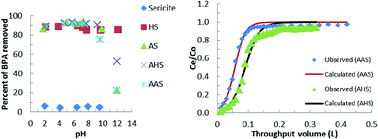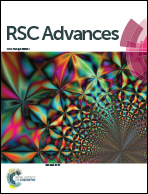Use of hybrid materials in the decontamination of bisphenol A from aqueous solutions
Abstract
Hybrid materials were obtained by modifying natural sericite. The sericite was modified with hexadecyltrimethylammonium bromide (HS) and alkyldimethylbenzylammonium chloride (AS) to obtain organo-modified sericites, together with aluminum-H-sericite (AHS) and aluminum-A-sericite (AAS) as inorgano–organo-modified sericite hybrid materials. The hybrid materials were characterized by FT-IR spectrometry, XRD and SEM. The pHPZC values of the solid hybrid materials were obtained by acid–base titration. The Brunauer–Emmett–Teller surface area and pore size of the hybrid materials were also determined. The resulting materials were used in the remediation of waste waters contaminated with bisphenol A (BPA) using batch and column reactor operations. The batch experiments showed that an increase in pH from 2.0 to 10.0 did not affect the percentage uptake of BPA by these hybrid materials, but at pH > 10.0 the percentage uptake of BPA decreased significantly for the AHS and AAS hybrid materials. An increase in the concentration of BPA (1.0–20 mg L−1) and the background electrolyte concentration (0.0001–0.1 mol L−1 NaCl) did not affect the percentage removal of BPA by these hybrid materials. The time dependence adsorption data showed that BPA was quickly taken up onto these hybrid materials as most of the BPA was trapped within the first few minutes of contact. The kinetic data fitted well to a pseudo-second-order and fractal-like pseudo-second-order model rather a pseudo-first-order model. The results of pseudo-second-order fitting showed that the removal capacities of the AS, HS, AAS and AHS hybrid materials for BPA were 4.816, 5.047, 4.874 and 4.856 mg g−1, respectively. In addition, AAS and AHS were used for dynamic studies in column experiments. The breakthrough curves were then used for the non-linear fitting of the Thomas equation. The loading capacity of the column for BPA using the AHS and AAS hybrid materials was estimated.


 Please wait while we load your content...
Please wait while we load your content...